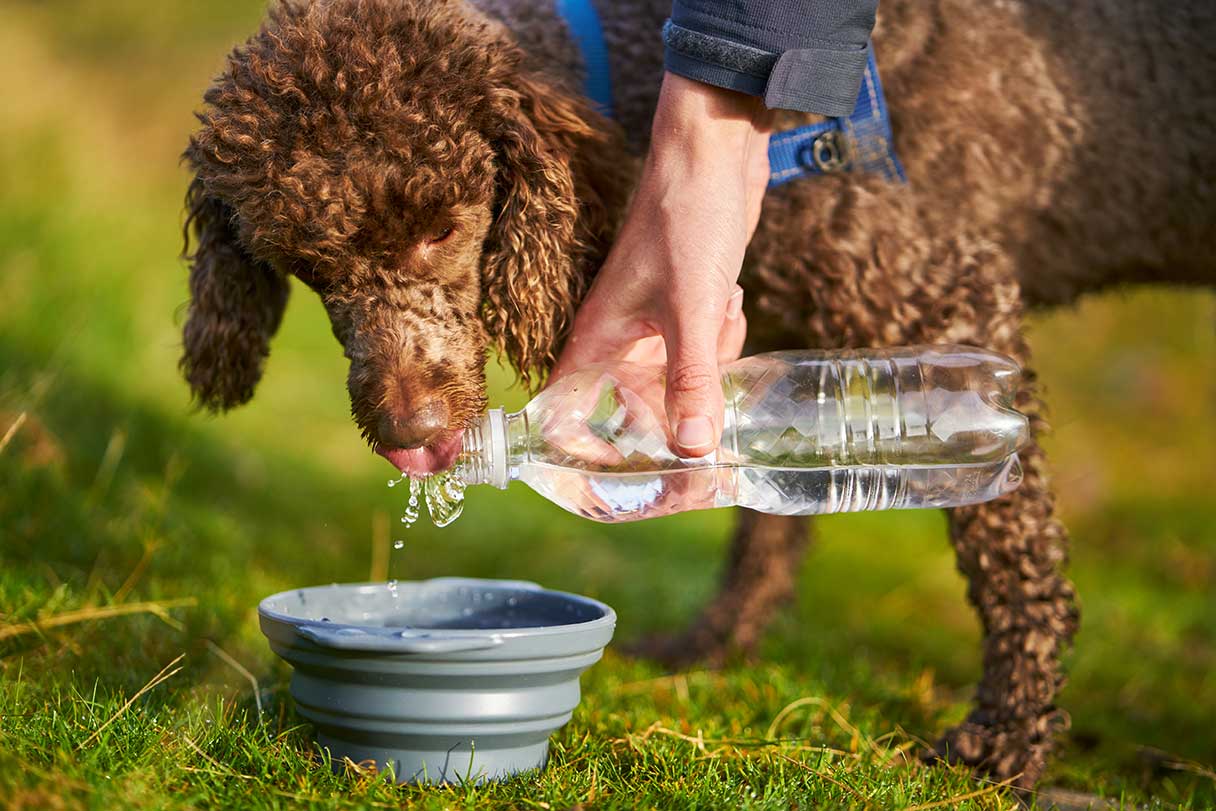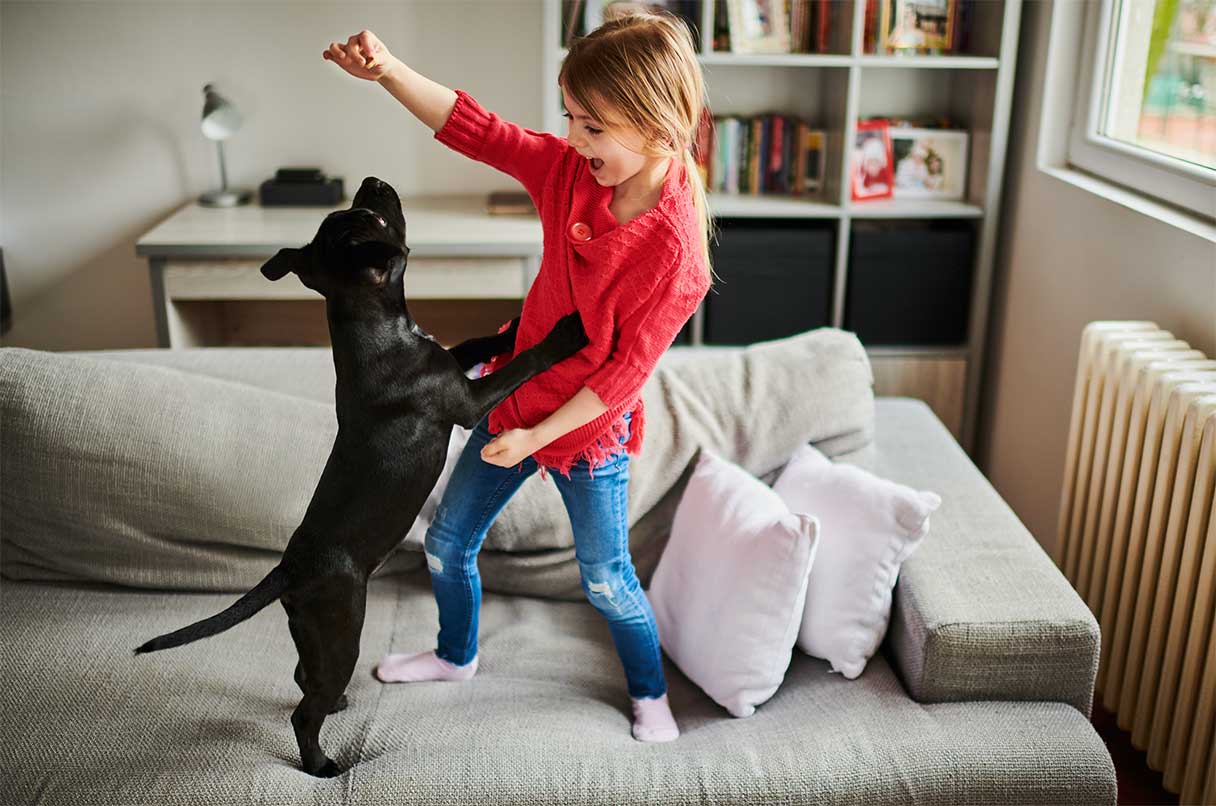While we often worry the most about our pets getting dehydrated in the summer because of high temperatures and humidity, the truth is that dehydration can occur any time of year. Dehydration — for humans, dogs and cats — is simply when the body loses more fluid than it is taking in.1
Water is essential for many of your pet's bodily functions, just like it is for us. H2O helps lubricate joints, support internal organs, aid digestion, regulate body temperature and assist the cells in absorbing nutrients. Young pets, seniors, nursing mothers and toy dog breeds are especially vulnerable to dehydration, so it’s important to know the signs as your dog or cat goes through their life stages.1
How Much Water Do Dogs and Cats Need Every Day?
For most dogs, a normal amount of water is 1 ounce per pound of body weight (give or take an ounce).1 This is the same for cats.2
For example, a 7-pound Chihuahua may only need 6 to 8 ounces (3/4 to 1 cup) of water per day, while a 40-pound Labrador retriever may need 40 ounces (or 5 cups) per day.
If your pet is drinking a lot more than this or goes to their water bowl every few minutes, they may be dehydrated. There may also be an underlying medical issue, so it’s a good idea to call your veterinarian to discuss.2
The important thing to remember is to always provide your dog or cat access to clean, fresh water so they can drink as they become thirsty and especially after walks, exercise or extended periods outside.1
Causes of Dehydration in Dogs and Cats
It’s normal for your pet to gain and lose water throughout the day from urinating or defecating, panting and their sweat glands. Dehydration occurs when your pet isn’t taking in enough fluid to make up for the loss. That can happen from the following situations:1
-
Being outside for too long without access to water (walking, hiking, playing in the yard, etc.)
-
Excessive diarrhea and/or vomiting related to an illness
Dehydration can also be a cause of an underlying problem, such as:3
-
Urinary tract infection (UTI)
-
Kidney disease
-
Liver disease
-
Adrenal gland diseases (Cushing’s disease or Addison’s disease)
-
Hyperthyroidism
9 Signs That Your Pet Is Dehydrated
Unfortunately, our pets can’t tell us when they are thirsty, but if you notice them drinking more or less water than usual, they may be dehydrated.
Other signs of dehydration include:1
-
Dry nose
-
Dry, sticky gums
-
Lethargy
-
Loss of appetite
-
Loss of skin elasticity (you can test this by gently pinching and pulling up your pet’s skin between their shoulder blades — in hydrated pets, the skin will spring back into place quickly)
-
Infrequent urination (your pet should urinate at least twice per day)4
-
Sunken eyes
-
Thick saliva
-
Vomiting
What to Do if Your Pet Is Dehydrated
Always provide your pet with fresh water, especially after walks or playtime. Occasionally, your pet might need electrolyte replenishment. Before offering anything other than water to your dog or cat, consult your veterinarian to determine the appropriate dosage and if this treatment is suitable.1
You may also give your pet water via a dropper or turkey baster (depending on their size) to ensure they are getting some liquid in their system. Tip your pet’s nose toward the ceiling, insert the dropper or turkey baster against the inside of their cheek and press the water out — slowly, so they don’t choke. Be sure to give your pet breaks after sips so they can swallow the water and breathe.4
If your pet is exhibiting symptoms of heatstroke (heavy panting, fatigue or collapse, elevated body temperature, disorientation or seizures), take them to the veterinarian immediately. Heatstroke is a life-threatening situation.5
Anytime you are concerned about your pet’s water intake or behavior — or if they exhibit the symptoms above — it’s a good idea to contact your veterinarian. They can administer subcutaneous (under the skin) or intravenous fluids to replace lost fluid quickly.1
9 Ways to Prevent Dehydration in Pets
The easiest way to prevent dehydration is to ensure that your dog or cat always has access to fresh, clean water, whether this is after a walk or playtime or simply while you are at work or out of the house for several hours at a time. (Tip: Many pets enjoy sipping from water fountains, as they provide fresh, clean water and a fun way for your furry friend to stay hydrated.)
Other ways to prevent dehydration in pets:
-
Incorporate wet food into their diet (wet food has a higher moisture content than dry food).2
-
Give your pet ice cubes to chew on.1
-
If your tap water has an off smell, try bottled or filtered water.4
-
Flavor the water with some no- to low-sodium broth, clam juice or salt-free tuna juice.4
-
Take water for your dog when you go on walks, hikes or other longer outdoor adventures.
-
Offer treats with high water content, like watermelon.
-
Keep your pet healthy and away from household hazards.1
Understanding the causes and symptoms of dehydration is important for keeping your pet safe. Being proactive by offering continuous access to clean, fresh water, recognizing symptoms early and knowing when to seek veterinary care can help your pet stay happy and healthy throughout the year.
CareCredit Credit Card Financing for Pets
Taking good care of your pet's well-being from nose to tail is essential. Make sure to stay up to date on their regular checkups at the vet to help keep your pet happy and healthy for a lifetime of love. You can use your CareCredit credit card for pet care throughout the year for routine veterinary services as well as emergencies and surgeries.* Use our Acceptance Locator to find a veterinarian near you that accepts CareCredit.
CareCredit is there for you and your pet every step of the way; continue your wellness journey by downloading the CareCredit Mobile App to manage your account, find a provider on the go and easily access the Well U blog for more great articles, podcasts and videos.
In addition to pet care, you can also use your CareCredit credit card for dentistry, cosmetic, vision, hearing, health systems, dermatology, pharmacy purchases, spa treatments and so much more within the CareCredit network. How will you invest in your health and wellness next?
Author Bio
Abbie Mood is a freelance writer with more than 15 years of experience. She has worked with clients of all sizes to create compelling content, and she has written for the American Kennel Club, Marriott Bonvoy, Women's Health Online, Headspace and more.







